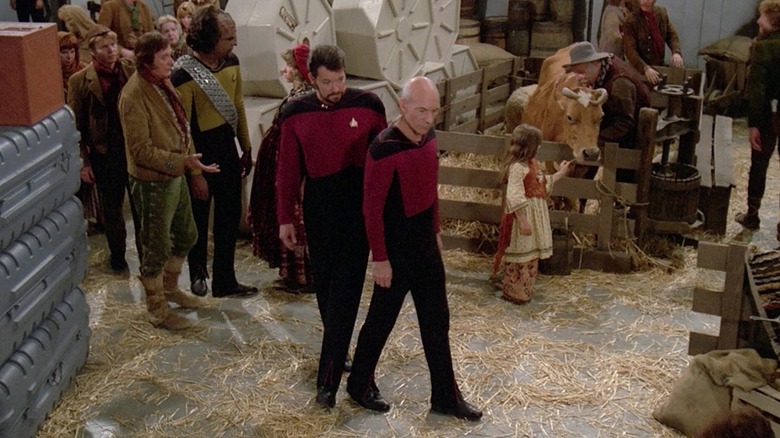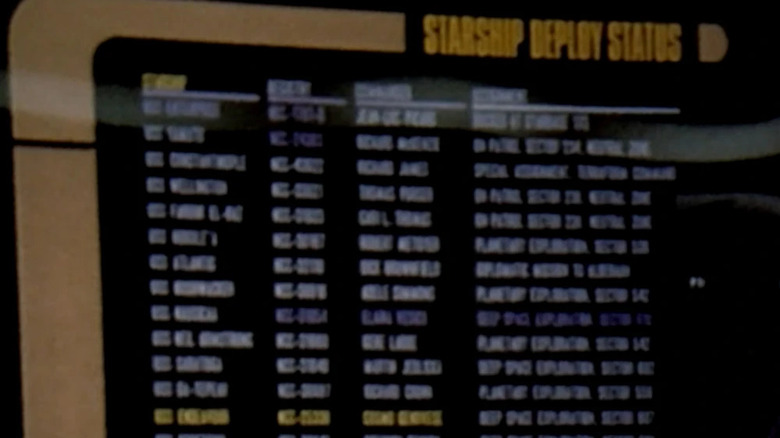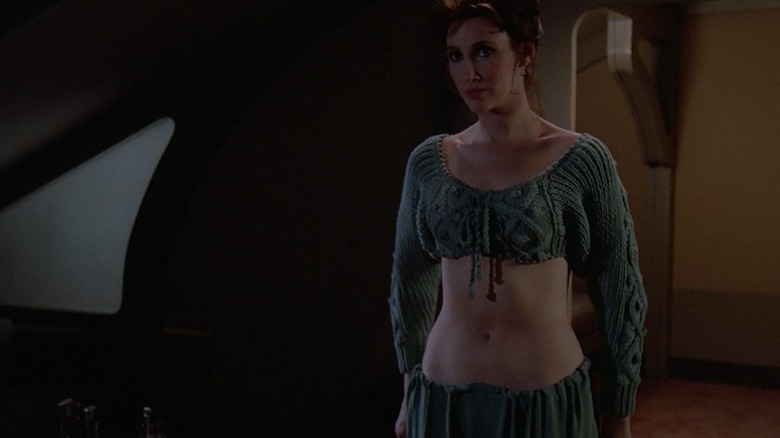Star Trek's Up The Long Ladder Brought A Famous Star Wars Planet Into Federation Space
Colloquially among Trekkies, the "Star Trek: The Next Generation" episode "Up the Long Ladder" (May 22, 1989) is known as "The one with the Space Irish." Or maybe I'm the only one who refers to it that way. Regardless, "Up the Long Ladder" features the Space Irish. In the episode, the U.S.S. Enterprise has to evacuate a colony on the planet Bringloid V, as their sun is experiencing solar flares. Long ago, the Bringloidians adopted an Irish agrarian lifestyle, and they bring along their livestock, hay, and twee Irish accents. The colony's patriarch, Danielo O'Dell (Barrie Ingham), is a caricature Irish drunk, and his daughter Breanna (Rosalyn Landor) is a typically haughty Irish lass.
It's later revealed that the Bringloidians represent only half of a century-old transport ship, and that the rest of the settlers formed their own colony on a nearby planet. The second colony, called Mariposa, is technologically advanced, but the colonists have lost their ability to naturally reproduce. They have resorted to cloning to keep their population robust, but even that is failing; they need new genetic stock. By the end of the episode, the Bringloidians and the Mariposans are reunited, and — in a twist the notoriously horny Gene Roddenberry would have approved of — asked to begin mating immediately.
A fun piece of trivia about "Up the Long Ladder," though, is that it features a tiny background detail that, if viewers are to accept it as canon, incorporates a noted "Star Wars" world into "Star Trek" universe. In a background starship manifest, a sharp-eyed viewer might note that the HMS New Zealand was sent to the planet Alderaan, the planet exploded by Darth Vader in the original 1977 "Star Wars."
Many such tiny background details are discussed in Larry Nemecek's indispensable book "The Star Trek: The Next Generation Companion."
Looking for love in Alderaan places
The tiny text seen on computer panels in "Star Trek: The Next Generation" usually contained in-jokes, clues, and the initials of crew members who worked on the show. Such details were not meant to be readable by audiences, as cathode ray tube TVs — the kind people owned in 1989 — didn't have the visual fidelity to present them with clarity. They were just cute little gags for the cast and crew to enjoy. These tiny texts were traditionally called Okudagrams by the crew, named after production designers Mike and Denise Okuda. It wouldn't be until the series had been remastered for Blu-ray that several Okudagrams would be made visible for the first time.
As someone who has visited the set (brag, brag), I have seen several Okudagrams close-up, including little buttons that warn people not to tug on Superman's cape or to not spit into the wind.
The "Next Generation" production designers had a ball making Okudagrams, often slipping in many, many references to their favorite sci-fi shows and movies. Picard (Patrick Stewart) calls up a deploy manifest in the Ficus sector, and many ship names and/or captains may be familiar. The New Zealand, for instance is on a "diplomatic mission to Alderaan." Another ship on the same manifest is called the U.S.S. Buckaroo Banzai, under the command of Captain John Whorfin, and is on a mission to Planet 10, Dimension 8. These are all references, of course, to W.D. Richter's bizarro 1984 film "The Adventures of Buckaroo Banzai Across the 8th Dimension."
One might also note a Captain Gene Roddenberry on the manifest, as well as ships called the U.S.S. Urusei Yatsura and the U.S.S. Tomobiki, both references to a celebrated 1978 manga and subsequent 1981 anime adaptation.
Alderaan vs. Aldebaran
Of course, because Okudagrams were meant to be private, in-jokes, when fans began noticing them, the showrunners had to undo or correct them as to not start mixing up sci-fi canon. After all, if "Star Wars" and "Star Trek" took place in the same universe, a new galactic history would have to be re-written. "Star Wars," for instance, takes place in "a galaxy far, far away" while "Star Trek" takes place in our own Milky Way. The ships in "Star Trek" haven't traversed outside of the Milky Way, as the next galaxy over, the Canis Major Dwarf galaxy, is 25,000 lightyears away. It's been said in "Star Trek: Voyager" that a ship traveling at Warp 9.975 can go 15 lightyears in two days. That would mean a ship would have to travel for 513 years to make it to the next galaxy.
In order to reach "a galaxy far, far away," then, a starship would either need to be zipping along without stopping for half a millennium, or there would need to be a wormhole of some kind. If it was a wormhole, such a rare phenomenon would have been discussed in Trek canon; it would be too important to remain obscure to the characters.
Also, there was the issue of Alderaan being destroyed a long time ago. This means the Trek-makers would have to address Alderaan's reconstruction, or they would have to invent a new planet that had the same name. Either would be too much of a headache for Trek purists.
As such, when it came time to remaster "Star Trek: The Next Generation" for release on Blu-ray, "Alderaan" was changed to "Aldebaran," a real-life star that was already included in "Star Trek" lore. Wild speculations, it seems, were ceased.


